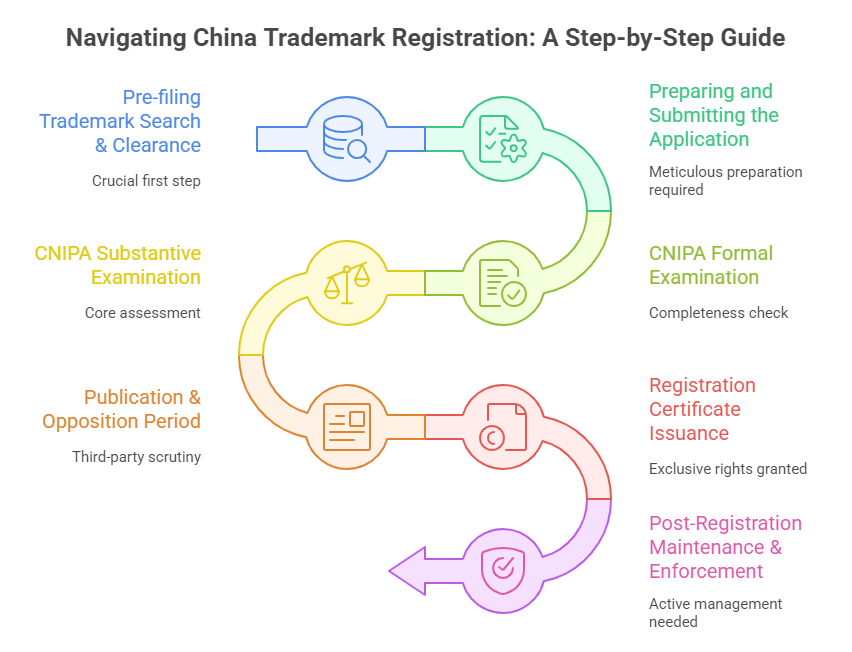Securing a trademark in China is not merely an administrative task; it’s a critical investment in your brand’s future within the world’s second-largest economy. China operates on a “first-to-file” principle, meaning rights are primarily granted to the entity that files first, not necessarily the first user. This system makes proactive registration essential for foreign companies seeking to establish and protect their brand identity in this vital market. Failure to register can leave your brand vulnerable to squatters and counterfeiters, potentially locking you out of your own market or leading to costly legal battles. This guide details every step of the official China trademark registration process, managed by the China National Intellectual Property Administration (CNIPA).

Step 1: Comprehensive Trademark Search & Clearance (Crucial First Step)
Before investing time and resources, conduct a thorough pre-filing search. This is non-negotiable. Search the CNIPA’s online trademark database for identical or confusingly similar marks (in Chinese characters, Pinyin, and your original language) across your relevant Nice Classification goods/services classes. Consider:
- Identical Marks: Direct matches to your proposed mark.
- Similar Marks: Marks that look or sound similar and cover related goods/services.
- Well-Known Marks: Even unregistered well-known marks enjoy broader protection.
Why this step is paramount: CNIPA examiners rigorously check for conflicts. Discovering a blocking mark before filing saves significant costs and delays later. Searches also reveal potential squatters. Due to the complexity of Chinese language and classification nuances, utilizing professional trademark search services is highly recommended to ensure accuracy and strategic assessment of risks. For expert assistance navigating trademark complexities in China, explore our dedicated Intellectual Property Verification services.
Step 2: Preparing and Submitting the Application
Once clearance is confirmed, prepare your application meticulously:
- Applicant Details: Full legal name, address, and nationality/country of incorporation of the overseas entity.
- Trademark Representation: Clear image file of your mark (black & white or color). If claiming color protection, specify.
- Goods/Services: Precisely list the goods/services using the Nice Classification system (45 classes). Overly broad descriptions invite objections. Chinese translations are often required.
- Power of Attorney (POA): A signed POA authorizing your chosen Chinese trademark agent is mandatory for foreign applicants. Notarization or legalization may be required depending on the agent’s requirements and jurisdiction.
- Priority Document (If Applicable): Claiming priority under the Paris Convention? Submit a certified copy of the foreign application within 3 months of the CNIPA filing date.
Mandatory Requirement: Foreign entities must file through a CNIPA-licensed Chinese trademark agency. You cannot file directly. Choose an experienced agent familiar with CNIPA procedures and foreign client needs.
Step 3: CNIPA Formal & Substantive Examination
- Formal Examination (1-2 Months): CNIPA checks application completeness (forms, fees, POA, classification). If deficient, a notice allows correction within a strict deadline.
- Substantive Examination (Approx. 7-9 Months): This is the core assessment:
- Distinctiveness: Does the mark distinguish your goods/services? Generic/descriptive marks face rejection.
- Absolute Grounds: Does it violate prohibitions (e.g., state symbols, deceptive/scandalous marks)?
- Relative Grounds: Does it conflict with prior registered/pending marks for similar goods/services?
- Deceptiveness/Misdescription: Could it mislead consumers about quality, origin, etc.?
Step 4: Publication & Opposition Period (3 Months)
If approved in examination, the mark is published in the CNIPA Trademark Gazette for 3 months. During this window:
- Third-Party Opposition: Any entity believing the mark violates their rights can file an opposition with CNIPA.
- CNIPA Adjudication: CNIPA examines opposition arguments. The applicant can defend their mark. This process can significantly extend registration time (often 12-18+ months). If no opposition or opposition fails, the mark proceeds to registration.
Step 5: Registration Certificate Issuance
Upon successful navigation of examination and opposition (if any), CNIPA issues the Trademark Registration Certificate. This grants the owner exclusive rights to use the mark on the registered goods/services throughout mainland China for 10 years from the filing date.
Step 6: Post-Registration Maintenance & Enforcement
Protection requires active management:
- Use It: Use the mark as registered within China. Non-use for 3 consecutive years makes it vulnerable to cancellation.
- Monitor: Actively watch for potential infringements or conflicting applications. Consider professional watch services.
- Renew: Renew the registration every 10 years. The renewal window is 12 months before expiry + a 6-month grace period (with late fees). Failure to renew results in loss of rights.
- Enforce: Take action against infringers through administrative complaints (local SAMRs), customs recordation, or civil litigation. Registration is the bedrock of enforcement. Keep your registration details current with CNIPA for effective enforcement and to manage crucial renewals via our streamlined Company Documents Retrieval service.
Why Partner with Experts?
Navigating China’s trademark system demands precision and local expertise. Challenges include:
- Language Barrier: Official proceedings are in Chinese.
- Complex Procedures: Strict formalities and nuanced examination.
- Cultural Nuances: Understanding what constitutes similarity or descriptiveness in the Chinese context.
- Enforcement Landscape: Effectively protecting rights requires local knowledge and strategies.
Conclusion
China trademark registration is a structured but intricate process. For overseas businesses, understanding the “first-to-file” imperative and meticulously following each step – from comprehensive searching and accurate filing through CNIPA agents, to navigating examination, publication, and diligent post-registration maintenance – is fundamental to securing and defending valuable brand assets. Partnering with experienced professionals is not just advisable; it’s often critical to achieving successful and enforceable trademark protection in this complex and dynamic market. Proactive registration is your strongest shield against infringement and the key to building lasting brand value in China.
